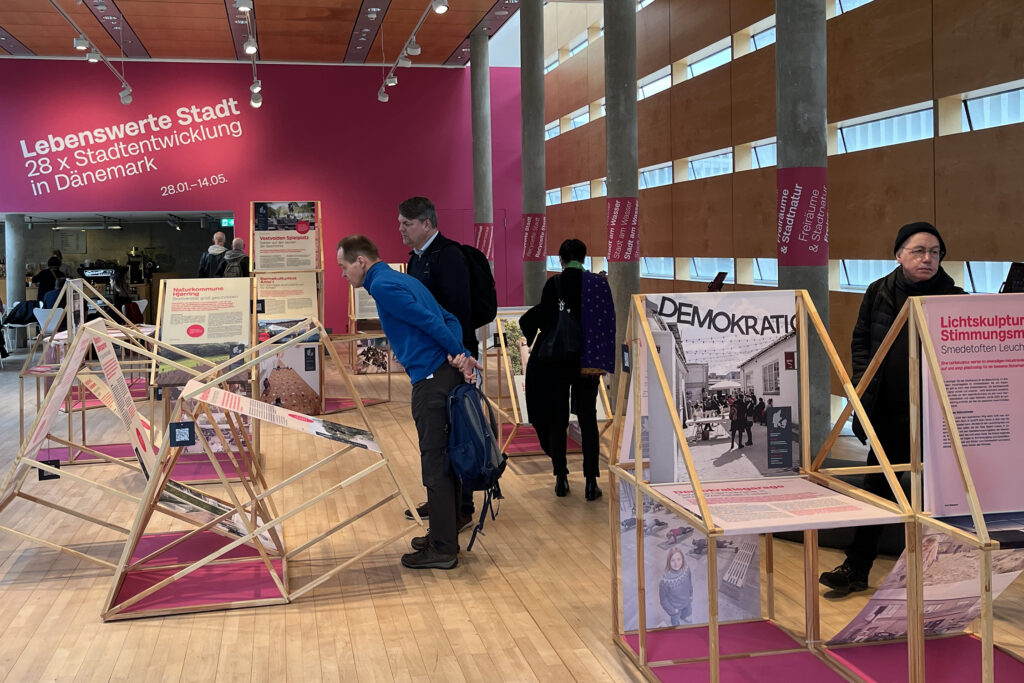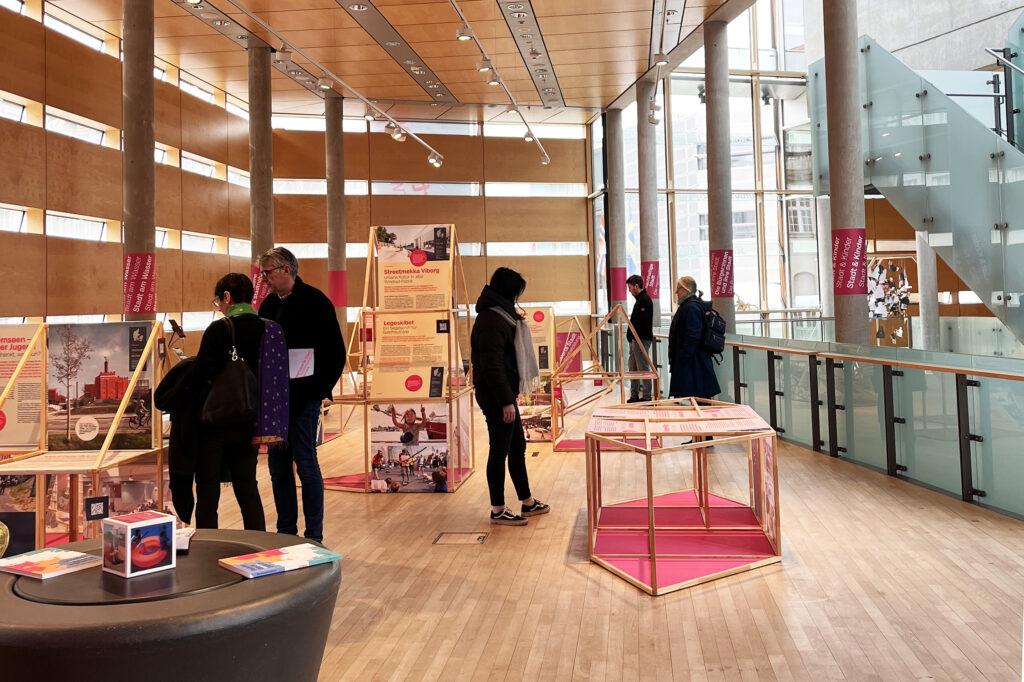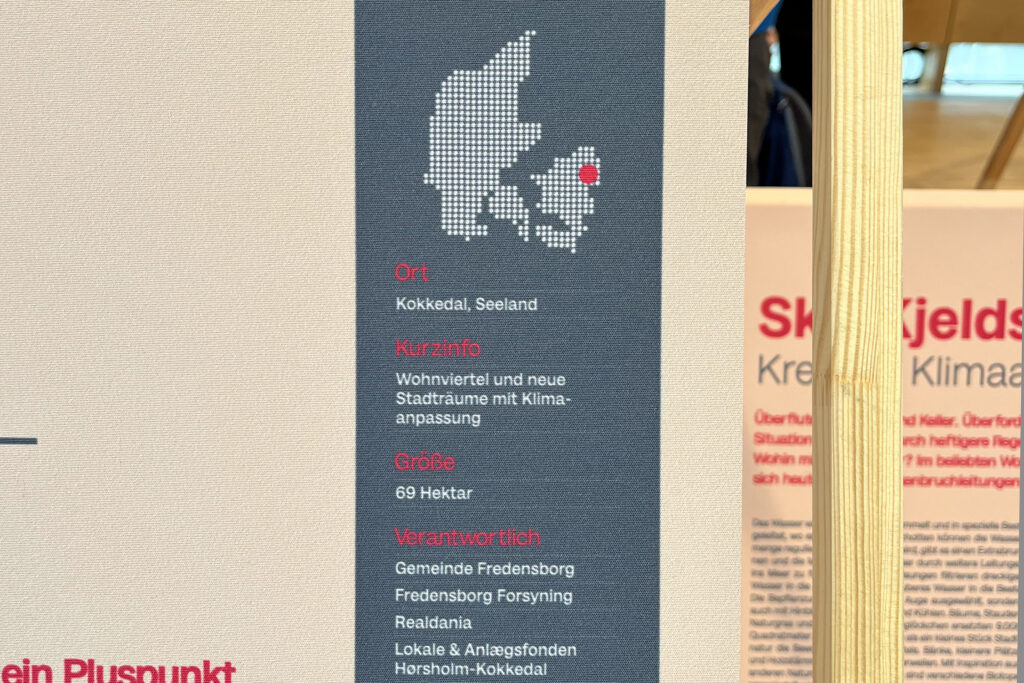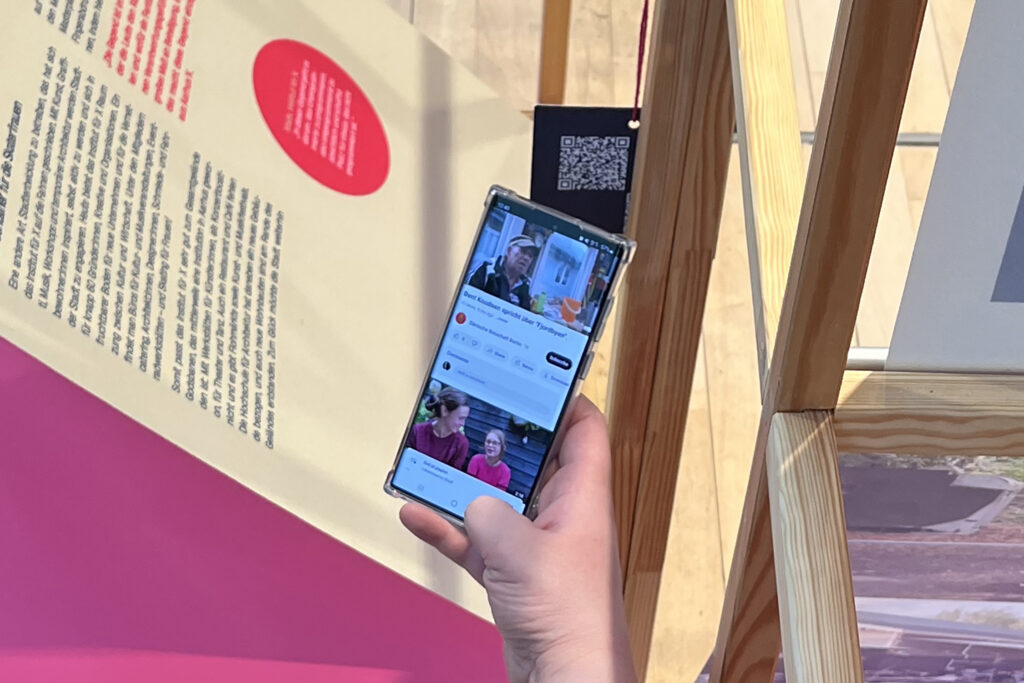01/23 – 05/23 Nordic Embassies, Berlin DE
How can a country bring discussions of urban development to new audiences, in foreign territory? Beyond traditional methods of exhibition displays, how else can visitors be engaged?

‘The Livable City, 28x Urban Development in Denmark’, is an exhibition concerned with sustainable architecture and urban planning, drawing on contemporary and historical case studies from across Denmark. It aims to promote awareness and discussion around future cities and the involvement of those who live there.
The exhibition is housed on the first floor of Felleshus, part of the Nordic Embassies complex in Berlin. On approaching the space, the visitor’s attention is drawn by the double height space marked by a full-height magenta-coloured wall with white large-scale graphics – signalling a text-based introduction to the The Livable City.
Atmospherically, the space avoids the structure or implied-direction of a traditional exhibition, where the visitor may feel they are being prepared to enter a controlled spatial experience. The feeling here could be anti-climactic for a visitor expecting an unfolding spectacle. In contrast, a small café counter sits on the edge of the space, with seating that casually spills into the exhibition. This relaxed approach is reinforced by the placement of Nordic furniture and designer products, available for visitors to buy.
Although set within Nordic Embassies and featuring Danish urban and architectural projects, the exhibition is aimed primarily at a German audience, with the text displayed in German language. On the day of visiting (on a Sunday) the visitors questioned were mostly German, either native to or visiting Berlin. Visitors in this scenario are seen taking time to read each information board in a methodical manner (image 1). To the outside observer, there was a good level of interest shown by the visitors, although this could be relative to the context of the Embassy setting, which requires a certain level of intent to visit, being unlike a typical museum or cultural venue.

To a non-German speaker, it is still possible to appreciate the qualities of some of the project examples, through the wide application of photography. The graphic design also aids universal understanding for the viewer, utilising a graphic location device, pin-pointing each project on a map of Denmark in a simple, legible manner (image 2). The digital elements, accessed via QR codes throughout the exhibition (and on iPads displayed within the space) take viewers to a range of short videos hosted on YouTube. The media is easy to access, and brings content to life, within an otherwise static space – although is restricted to the scale of a handheld device (image 3).


The exhibition content of text and image on a range of printed banners, is displayed across the space by means of a series of lightweight timber structures. The angular forms created by the structures accommodate a range of viewing heights for the printed content, from low-level to standing height. The bases of the freestanding structures are punctuated with solid magenta at floor level, which sets them apart from the timber floor finish they sit upon. Where the angular forms are visually interesting, from a practical stance it also presents challenges with viewing the projects, requiring the viewer to lean or squat to bring content into eye-line.
Although not optimal from an experiential viewpoint, the lightweight timber structures and detachable banners are suited to both transportation (as a travelling exhibition, as intended) and future end-of-life repurposing or recycling. Curator for the exhibition Birgitte Tovborg Jensen explained that practical considerations were key to this project, over technological means:
The digital elements were not the main focus of this exhibition and we did not plan them very intensively into the exhibition concept… The QR codes could certainly be better integrated, but the main part of the exhibition are the modules. It was planned this way to make the exhibition robust and easy to handle for all kinds of locations and partners – not depending on technology and tending.
The exhibition fundamentally aims to show urban spaces that are created for people, and the life that happens in-between buildings, – moving away from the car-centred planning of the 1960s. In presenting these exemplars from across Denmark, the exhibition relies on the visitor to engage on a personal level, taking sufficient time to read text about individual projects, and to view and consider the accompanying photography.
Key to the success of the exhibition is a wider programme of events aimed at community engagement and discussions- such as an organised city tour by bicycle, followed by a symposium about bike-friendly cities, involving local voices and policy makers. Tovborg Jensen highlights that Denmark is viewed as an exemplar in urban planning, which brings gravitas to other well-attended panel events on architecture and urban planning, hosted by the venue.
The exhibition is undoubtedly people-focussed, and the community projects on show are seemingly appreciated by those who take the time to engage. The exhibition received positive and suggestive feedback, gathered by the venue:
- ‘Creative and innovative realisations, please also draw the attention of Berlin’s politicians to this!’
- ‘An important issue for all major cities, no matter where they are in the world. The current policy of giving preference to the car will hopefully soon be passe!’
- ‘Exciting, could be a little critical of the gentrification issue’
- ‘We need to discuss and change the quality of the city to public space with everyone’
- ‘Interesting, livable and democratic city concepts. Could be models for German cities’
‘The Livable City’ exhibition allows viewers to enjoy the projects on show, in their own time, in a casual and welcoming environment – which in turn allows the case studies to be appreciated, and subtly prompts the viewer to investigate (and become involved) further. In this case, the physical exhibition provides a temporarily fixed attraction, as part of a wider initiative which itself proved to both educate, and prompt lively debate between the public and local decision-makers.
Engaging communities with urban planning and decision-making can be viewed as a positive act, and initiatives such as this exhibition give greater opportunity for dissemination, learning and discussion. In the absence of 3D models, more sophisticated interactives, or more imaginative use of media, the experience of this exhibition is not unlike reading a book, requiring a level of agency from the viewer. It could be argued that this level of engagement is similar to that required from those wishing to be more involved in issues affecting their urban environments.
Exhibition review: B. Couture & T. Ahmed, 2023
Footnote: About the host building
Sited within the Mitte district of Berlin, the host building is part of a suite of embassies, 5 in total, making up the Nordic Embassies complex – representing Denmark, Finland, Iceland, Norway and Sweden. The separate ‘Felleshus’ building acts as the ‘community house’. Created between 1995-1999 by Berger Parkkinen Architects, the wider concept aims to achieve a ‘modern culture and event centre’ – consisting of six individually-designed buildings, united by a flowing copper band that wraps around site. The temporary exhibition in question is one part of an ongoing offer within the Felleshus, that regularly includes readings, film screenings, lectures and events.